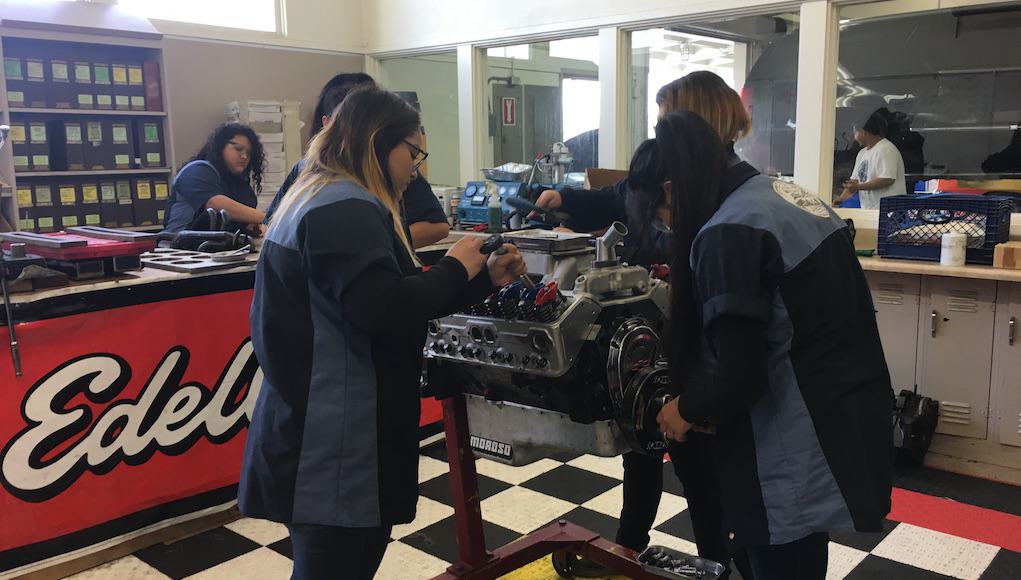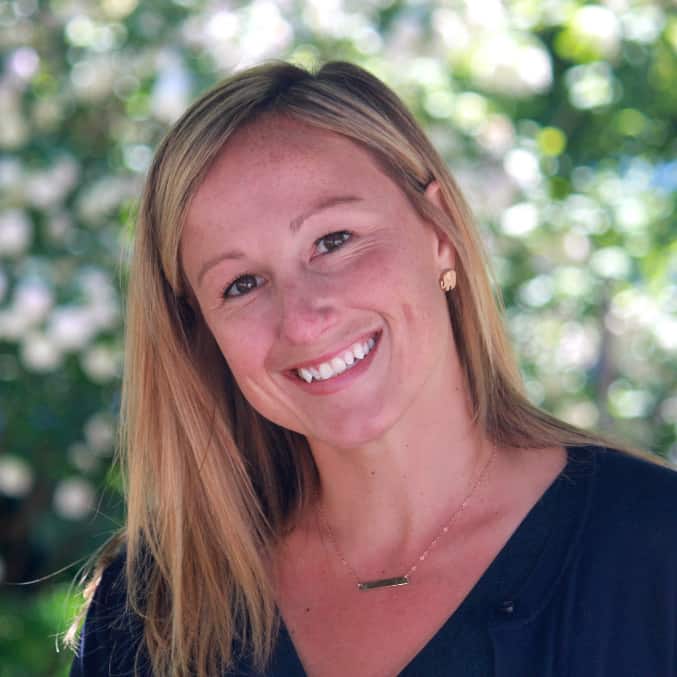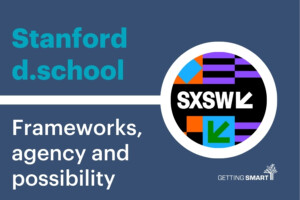Santa Ana Unified Creating Incredible Pathways for Students K-12

By Emily Liebtag and Tom Vander Ark
When people think of large urban districts, they often think about all the challenges that they face. And it’s true–large urban districts often have to overcome many hurdles. But these challenges are not insurmountable. For example, despite facing many of the common challenges, Santa Ana Unified School District (SAUSD) is nonetheless redefining that preconception and creating incredible learning environments for K-12 students. They are choosing to focus on the strengths they have as a district and of the students and families that attend their schools.
A bit of background–Santa Ana is located in Southern California, just north of the Orange County Airport. It is the nation’s 4th most densely populated city, and one of the schools–Valley High School (which I will share more about in this post)–is located in one of the densest square miles in the United States. It is the seventh largest school district in the state of California with 62 schools and approximately 58,000 students. About 91% of students are eligible for free and reduced-priced meals and 60% of SAUSD students are English Language Learners, representing Santa Ana’s many thriving communities and rich variety of cultures.
More students are graduating from SAUSD schools and persisting into college than ever before. The graduation rate in SAUSD is 91.6%, beating the average of both Orange County and the State of a California despite significantly higher ELL and poverty percentages than both. There are many SAUSD graduates who choose to enter college via Santa Ana College because of the Santa Ana Promise, which provides an AA degree without cost and guarantees a transfer to UCI or Cal State Fullerton. All they need to do is graduate from high school.
These results, amongst many other positive quantitative and qualitative outcomes the district has seen over the last decade, may in part be due to the intentional focus of the district leaders and staff on innovating in ways that stand to benefit students and families that they serve. As Tom stated in a podcast post about SAUSD, they offer three important innovations to students and families:
- High-access strategy: school-based decisions about devices and deployment;
- Portfolio strategy: a shift from district-led managed instruction to school-led personalized learning; and
- New school development strategy: promoting school options and incubating next gen models.
The implementation of all three of these ideas has led to some incredible outcomes and options across campuses in the district. Let’s take a look at some of the work going on in SAUSD.
Career and Technical Education Pathways
The career and technical education (CTE) options in SAUSD are intended to achieve the aforementioned innovation goals. Across K-12, there are CTE options for students, but do not think for one second this is like the traditional vocational education courses you had growing up.
All too often, these pathways are for students who are labeled as “only having the potential for a service job right out of high school. That is tragic. SAUSD is redefining CTE to be the way to learn for all students and arguably has one of the best programs in the country.
I visited Valley High School to see the CTE pathways in action. Don Isbell (Director of CTE in SAUSD) and David Haglund (Deputy Superintendent) shared more about the pathways. There are over 34 CTE pathways offered in SAUSD to students. At the high school level, including at Valley, students have dual enrollment (receive both high school and college credit for taking a college-level career technical course), can earn college credit and certificates (including some of the highest certifications for each respective field, such as a earning certification to be a Certified Solid Works Associate).

This school campus, which has about 2150 students, has transformed over the last several years under the leadership of Principal David Richey. Dropouts have gone down (close to 4.5%) and graduation rates have gone up (close to 92%). This is certainly impressive, but the engagement levels, enthusiasm and overall culture of the school is remarkable. Students at Valley seem just as excited to come to high school as kindergartners do on their first day. The same level of engagement goes for Valley parents, too! Parents regularly come to the school and can attend classes in the Parent and Community Center during the school day.




One reason David Richey and others feel Valley is on the rise is due to the robust CTE program. There are six Valley–specific pathways including Transportation, Culinary Arts & Hospitality, Design, Engineering Design, Global Business and Health Science & Medical Technology. From working with leading marketing firms to create advertisements to growing plants in their hydroponic garden, the authentic projects and products produced in these pathways are the real deal.
Not only do they offer these pathways, but they are leading in national competitions in many of the fields their programs are preparing students to enter. The Culinary Arts and Transportation pathways have teams that consistently demonstrate excellence. Led by Chef Tiffany Heremans from Mexico City, the culinary team cooks for local shelters and events. They also use plants grown in their hydroponic garden and learn about sustainable gardening. During my visit, they were finishing up making squash blossom poppers.

Teachers are integrating subjects into their pathways and ensure that students are the best at what they are being trained to do. Saul Garcia, who works with students in the Transportation pathway, justifiably bragged about this outstanding all-female engineering team that has learned to work together and communicate all through working on automotives. He also shared that he loves when students pursue a pathway, but then decide they want to do something else. He shared a story about a student who excelled in Transportation, but then was determined to take the problem-solving skills he learned and pursue being a doctor instead. The student shared with Saul that having really learned a skill set well and working in a team showed him he would do anything he put his mind to.

Students in the Health Science and Medical track shared that they weren’t sure they wanted to go into the field, but said that after some hands-on experience and applying what they learned in anatomy, they are sold.

Another reason Valley students are thriving is the Nicholas Academic Center (NAC). The Nicholas Academic Center (NAC) at Valley has helped students get into many of the nation’s top colleges. Last year, SAUSD had four Gates Millennium Scholars, including one from Valley who went on to study at Notre Dame. The other three pursued programs at MIT, Harvard and USC. Located on the Valley campus, this is a center intended to provide students with academic support, help them learn about and apply to colleges, and encourage them to persist in whatever field they choose to pursue. The center is open after school and support is available to students until 7:00 pm at night. Pictures of students and where the choose to attend college cover the walls and inspire current Valley attendees.
Also located on the campus is the High School Inc. office. High School Inc. is a 501(c)(3) that is a partnership of the Santa Ana Chamber of Commerce, Santa Ana Unified School District and High School Inc. Foundation. They provide small-group learning environments in which students acquire the specific skills needed to secure employment in high-growth, high-tech industries, such as those environments found at Valley. Mark McLoughlin, President of High School Inc., said that having a High School Inc. office right on the Valley Campus has improved feedback and relationships with students and the businesses that they partner with in their CTE pathways.

David Richey, Principal of Valley High School said, “This is not rocket science. You have to pay attention to who your students are and provide them quality options and learning environments so they feel and know that school has relevance and meaning.”
Voice and Choice
Ensuring that decisions are made at the school level and that there is choice in what the school wants to focus on (see innovation goals 1 and 2) requires that those that are a part of that community have voice and choice. Therefore, across the district there is an on-going commitment to placing the voices of the school community–especially the students–front and center. The movement towards more voice and choice has proven to be a positive shift for SAUSD.
I also visited Heninger Elementary School (PreK-6), where students were using their voices and their stories to create films in the fourth grade. But not just your average YouTube clip–they produce really high-quality films. The fourth graders work to write, direct and produce films along with the help of local film industry experts and their incredible teacher, Genevieve Lunt, who was the first to take this idea on. David Haglund and Genevieve talked and both agreed that these group of students, almost all Latino and many English Language Learners, had so many things to share and stories to tell but needed the platform and skills to do so. The film project allows students to choose what they want to write about and how they want to share their stories.
The film concept was developed by Edward James Olmos and the Latino Film Institute. It is referred to as the LFI Youth Cinema Project (watch a video about the project to learn more). In SAUSD, the film academy begins in 4th grade and continues through high school. The culminating or capstone courses are offered in conjunction with the Dodge Film School at Chapman University. SAUSD film students have access to several full tuition scholarships at Chapman, which are accessible to those who complete the film pathway.

Not only is student voice included in daily teaching practices (see how they are using restorative justice practices that are intended to encourage connections and conversations) at places like Heninger and Valley, but there are even events focused solely around inviting students to share their ideas.
SAUSD leaders Wes Kriesel and Daniel Allen, along with David Haglund, have arranged four such events called #truth2power. At #truth2power, students voice their stories to policymakers and leaders in the entertainment field, who engage in return with words of affirmation, wisdom and encouragement. The events have sparked incredible conversations amongst students and staff. Watch the video of the event to witness some of what students shared and check out the photo album.

The same idea of voice and choice applies to teachers and admin in the district. Wes and Daniel have worked to highlight administrators voices through their Interviews with Principals of Change series.
We know there is even more going on within SAUSD that is exceptional and notable. We are beyond impressed with the work going on in SAUSD and will continue to look to them as they lead the way in redefining what it means to make learning meaningful for all students.
For more, see:
- Getting Smart Podcast | Santa Ana Unified School District
- Getting Smart Podcast | Principals Supporting Teachers as Curriculum Designers
- Interviews with Principals of Change
Stay in-the-know with all things EdTech and innovations in learning by signing up to receive the weekly Smart Update.




0 Comments
Leave a Comment
Your email address will not be published. All fields are required.